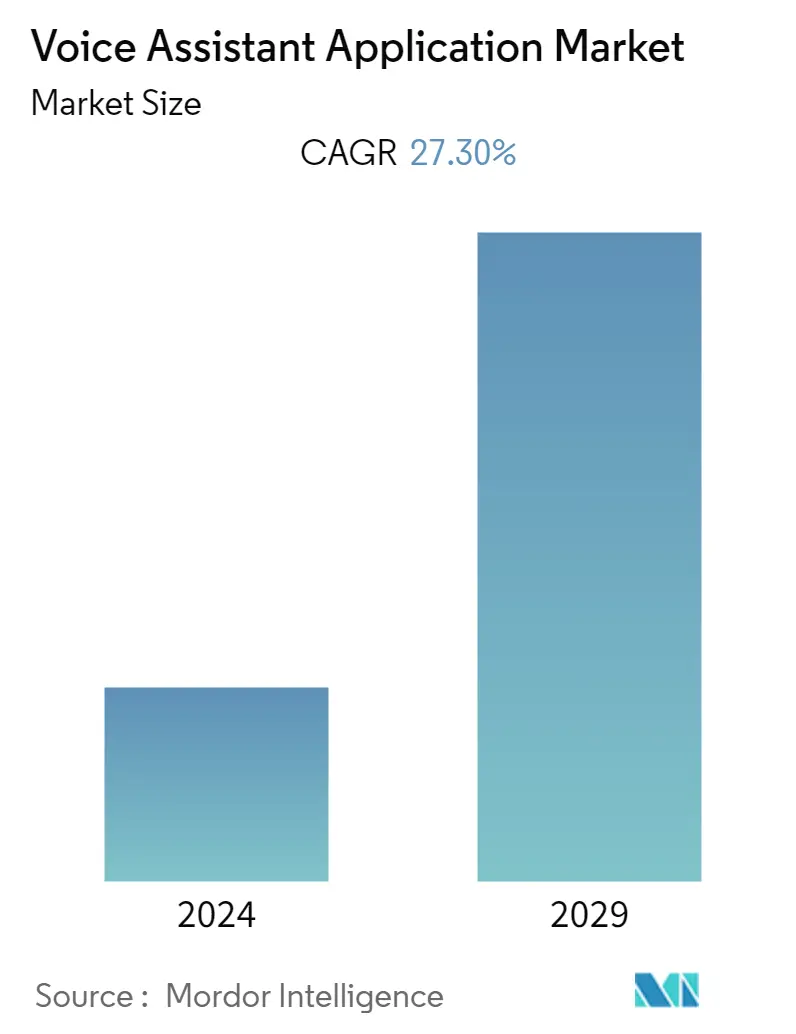
| Study Period | 2019 - 2029 |
| Base Year For Estimation | 2023 |
| Forecast Data Period | 2024 - 2029 |
| CAGR | 27.30 % |
| Fastest Growing Market | Asia Pacific |
| Largest Market | North America |
| Market Concentration | Medium |
Major Players
*Disclaimer: Major Players sorted in no particular order |
Voice Assistant Application Market Analysis
The voice assistant application market is projected to grow at 27.3% CAGR during the forecast period. A voice assistant is primarily a digital assistant built using AI, machine learning, and voice recognition technologies. Voice assistant applications can follow voice commands and assist in doing routine work like placing an online order, scheduling an appointment, switching on connected lights, and acting as a hassle-free facilitator for texting or calling.
- According to the "Cisco Annual Internet Report," the number of devices connected to internet networks will be more than three times the worldwide population by this year. As per the report, there will be approximately 3.6 networked devices per capita by this year, up from 2.4 devices per capita in 2018. Also, it further projects that there will be 29.3 billion networked devices by this year, up from 18.4 billion in 2018. Various new devices in different form factors with improved capabilities and intelligence are developed and adopted in the market every year. As the connected devices count increases, voice assistant application solutions will be adopted.
- Some voice assistant applications which have gained recognition across all sectors are Apple's Siri, Microsoft's Cortana, and Google's Assistant. Moreover, small and medium enterprises are also involved in driving intelligent voice assistant technology, thereby emerging as crucial participants in the voice assistant application market.
- Voice-based systems, which allow users to speak a query, have become increasingly common among businesses. However, voice-based technologies are known as bandwidth hogs and can efficiently overburden network performance, specifically if they use a cloud-based infrastructure. This is expected to harm voice-based technology adoption for businesses struggling with such issues. Edge computing is one of the promising technologies that can support voice-assisted devices. Edge computing technology places high-performance storage and network resources as close as possible to the end users and devices.
- Customers can only receive assistance from voice assistants fed with precise data when they ask inquiries that are preprogrammed to be answered. As a result, if a client asks a question about which the voice assistant is in the dark, it won't be able to understand what they mean and won't be able to respond to their question. People favor their regional languages above English for daily communications in nations with several regional languages, such as Indonesia and India. In India, improvements in speech recognition have made it possible to comprehend Indian regional languages better.
- At the time of the COVID-19 pandemic, popular voice assistant applications offered fairly straightforward insights on rising case trends, safety instructions from the World Health Organization (WHO), Centers for Disease Control and Prevention (CDC), and National Institutes of Health (NIH).
Voice Assistant Application Industry Segmentation
Voice assistant application offers voice searching, voice commands, and voice-activated device control. The market scope of voice assistant applications tracks the adoption of different technology-enabled solutions and services used by several end-use industries such as IT & telecommunication, BFSI, travel & tourism, healthcare, retail, automotive, etc. The study also focuses on the impact of COVID-19 on the market ecosystem. In the report scope, the existing technology provider landscape has also been covered, which consists of major players operating in the market.
The Voice Assistant Application Market is segmented by Component Type (Solutions, Services), Type of Technology (Natural Language Processing, Speech Recognition), Deployment Type (On-Premise, Cloud), Enterprise Size (Small and Medium Enterprises, Large Enterprises), End-user Verticals (IT & Telecommunication, BFSI, Healthcare, Retail, Automotive), and Geography (North America, Europe, Asia Pacific, Latin America, and Middle East & Africa).
The market sizes and forecasts are provided in terms of value (USD million) for all the above segments.
| Solutions |
| Services |
| Natural Language Processing |
| Speech Recognition |
| Other Technologies (Text to Speech Conversion, Edge Computing) |
| On-Premise |
| Cloud |
| Small & Medium Enterprises |
| Large Enterprises |
| IT & Telecommunication |
| BFSI |
| Healthcare |
| Retail |
| Automotive |
| Other End-use Verticals (Media and Entertainment, Educational Institutions) |
| North America |
| Europe |
| Asia |
| Australia and New Zealand |
| Latin America |
| Middle East and Africa |
Voice Assistant Application Market Size Summary
The voice assistant application market is experiencing significant growth, driven by advancements in artificial intelligence, machine learning, and voice recognition technologies. These applications serve as digital assistants, facilitating tasks such as online ordering, appointment scheduling, and controlling smart home devices through voice commands. The increasing number of connected devices globally is propelling the adoption of voice assistant solutions across various sectors, including healthcare and retail. Prominent players like Apple's Siri, Microsoft's Cortana, and Google's Assistant are leading the market, while small and medium enterprises are also contributing to the technology's expansion. However, challenges such as bandwidth consumption and the need for precise data input remain, particularly in regions with diverse linguistic preferences.
In North America, the voice assistant application market is bolstered by a robust presence of technology providers and a high adoption rate of connected devices. The region's market is characterized by strategic partnerships, mergers, and innovative solutions aimed at maintaining competitiveness. The United States, in particular, is a major contributor to this growth, with voice assistants being widely used in sectors like BFSI, media, entertainment, healthcare, and retail. The market is moderately competitive, with key players focusing on research and development, strategic alliances, and expanding their global customer base. Recent collaborations and product launches, such as Amazon and Disney's "Hey Disney" voice assistant, highlight the ongoing innovation and integration of voice technology in various applications.
Voice Assistant Application Market Size - Table of Contents
1. MARKET DYNAMICS
-
1.1 Market Drivers
- 1.1.1 Rising Usage of Cutting-edge Technology-based Connected Devices
-
1.2 Market Challenges
- 1.2.1 Accuracy Problems Related to Voice Assistants
2. MARKET SEGMENTATION
-
2.1 Component Type
- 2.1.1 Solutions
- 2.1.2 Services
-
2.2 Type of Technology
- 2.2.1 Natural Language Processing
- 2.2.2 Speech Recognition
- 2.2.3 Other Technologies (Text to Speech Conversion, Edge Computing)
-
2.3 Deployment
- 2.3.1 On-Premise
- 2.3.2 Cloud
-
2.4 Enterprise Size
- 2.4.1 Small & Medium Enterprises
- 2.4.2 Large Enterprises
-
2.5 End-user Verticals
- 2.5.1 IT & Telecommunication
- 2.5.2 BFSI
- 2.5.3 Healthcare
- 2.5.4 Retail
- 2.5.5 Automotive
- 2.5.6 Other End-use Verticals (Media and Entertainment, Educational Institutions)
-
2.6 By Geography
- 2.6.1 North America
- 2.6.2 Europe
- 2.6.3 Asia
- 2.6.4 Australia and New Zealand
- 2.6.5 Latin America
- 2.6.6 Middle East and Africa
Voice Assistant Application Market Research Faqs
What is the current Voice Assistant Application Market size?
The Voice Assistant Application Market is projected to register a CAGR of 27.30% during the forecast period (2025-2030)
Who are the key players in Voice Assistant Application Market?
IBM Corporation, Microsoft Corporation, Google LLC (Alphabet Inc.), Amazon Web Services, Inc. and Apple Inc. are the major companies operating in the Voice Assistant Application Market.


